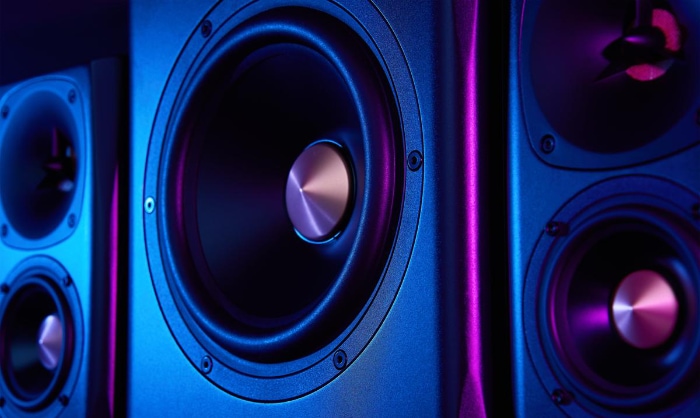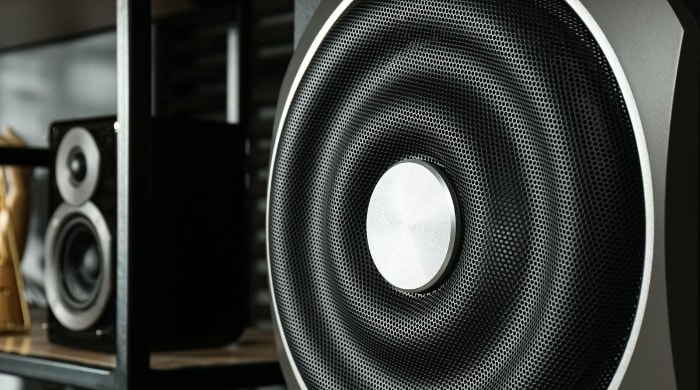Active vs. Passive Subwoofers: Decoding Your Perfect Match

Choosing the right subwoofer can be a game-changing decision for any audio setup, whether it’s for your home theater, car, or professional studio. While the general purpose of a subwoofer—to enrich the low-frequency sound in your audio system—is straightforward, the intricacies of different subwoofer types are less so.
Two categories dominate the market: active and passive subwoofers. While both aim to enhance your auditory experience, they do so in fundamentally different ways.
Active Subwoofers: An Overview
When it comes to user-friendly, plug-and-play options for enhancing low-frequency audio, active subwoofers stand out. Equipped with built-in amplifiers, these subwoofers offer a straightforward approach to improving sound quality.
This makes them ideal for various applications, from home theaters to compact audio setups.
What Are Active Subwoofers?
An active subwoofer is an all-in-one solution for low-frequency sound reproduction. Unlike its passive counterpart, it has a built-in amplifier.
This means you can directly connect it to the sound source without needing an external amplifier. Because of this integrated system, active subwoofers are generally easier to install and use.
The Built-in Amplification Advantage
One of the significant benefits of having a built-in amplifier is the simplification of the audio setup. You don’t need to match the subwoofer with an appropriate external amplifier, which can be a complex task requiring some technical knowledge.
The manufacturer has already done the matching for you, ensuring optimal performance.
Common Use-Cases for Active Subwoofers
Active subwoofers are versatile, but there are scenarios where they particularly shine.
- Home Theaters: Their ease of setup makes them perfect for residential environments where one may not have extensive audio engineering experience.
- Portable Sound Systems: The built-in amplifier means fewer components to carry, making active subwoofers a popular choice for portable setups.
- Small Music Venues: In settings where space is a constraint, the compact design of active subwoofers is beneficial.
Pros and Cons of Active Subwoofers
While active subwoofers offer several advantages, they come with their own set of limitations.
Pros
- Simplicity: Easier to set up and use
- Fewer Components: No need for an external amplifier
- Ideal for Compact Spaces: The all-in-one design saves space
Cons
- Cost: Generally more expensive due to the built-in amplifier
- Limited Customization: Less flexibility in tweaking individual components
- Potential Heat Buildup: Amplifiers can generate heat, which is contained within the subwoofer unit
Passive Subwoofers: An Overview
For those who seek a high degree of customization in their audio systems, passive subwoofers present an attractive option. Unlike active subwoofers, passive models require an external amplifier to function.
While this entails a more intricate setup, it offers greater control over individual components, making it a favorite among audiophiles and professional sound engineers.
What Are Passive Subwoofers?
A passive subwoofer is a type of speaker designed exclusively for low-frequency sound reproduction, but it lacks an internal amplifier. This means that an external amplifier is necessary to power the subwoofer, enabling it to produce sound.
The Need for External Amplification
The absence of a built-in amplifier creates both challenges and opportunities. On the one hand, you must find an amplifier that pairs well with your subwoofer, which can require a fair amount of expertise.
On the other hand, this setup allows you to fine-tune your audio experience, as you can select an amplifier that meets your specific needs.
Common Use-Cases for Passive Subwoofers
While passive subwoofers are versatile, they find particular favor in specific environments.
- Commercial Theaters: Large spaces often require highly customized sound setups, where passive subwoofers excel.
- Professional Sound Studios: The fine-tuning possible with an external amplifier makes passive subwoofers desirable in professional audio environments.
- High-End Home Theaters: For those willing to invest in advanced home audio systems, the customizability of passive subwoofers is a strong draw.
Pros and Cons of Passive Subwoofers
Just like active subwoofers, passive models come with their own set of advantages and drawbacks.
Pros
- Cost-Effectiveness: Generally less expensive if you already own a compatible amplifier
- High Customizability: Allows for more control over the audio output
- Component Replacement: Easier to replace individual components when needed
Cons
- Complexity: Requires a more detailed setup
- Multiple Components: More pieces to manage, including cables and the external amplifier
- Requires Space: Given the additional components, a passive setup often takes up more room
Critical Components Affecting Performance
The performance of a subwoofer is not solely determined by whether it is active or passive. A variety of components influence how well a subwoofer functions and how it contributes to the overall audio experience.
Amplifiers
Amplifiers serve as the power source for the subwoofer, enabling it to produce sound. In active subwoofers, these are built-in, while for passive subwoofers, an external amplifier is required.
The wattage and impedance matching are critical considerations, as they determine the loudness and quality of output.
Drivers
The driver is the cone-shaped element that moves air to produce sound. Drivers come in various sizes, typically ranging from 8 to 15 inches for consumer subwoofers.
The size and material of the driver influence the subwoofer’s efficiency and frequency response.
Enclosures
The enclosure or cabinet houses the driver and, in some cases, the built-in amplifier in active subwoofers. The design of the enclosure impacts the sound quality significantly.
Sealed, ported, and bandpass are common types of enclosures, each offering different sound characteristics.
Signal Processing
This involves the manipulation of the audio signal before it reaches the amplifier. Some subwoofers come with built-in signal processors that offer features like equalization and phase control, which can further refine the audio output.
Cross-over Frequencies
The cross-over frequency is the point where the subwoofer takes over from the main speakers to produce low-frequency sounds. Setting the correct cross-over frequency ensures a smooth transition between the subwoofer and the main speakers, leading to a more cohesive audio experience.
The Importance of Use-Case in Your Choice

When it comes to selecting the perfect subwoofer, understanding your specific use-case is paramount. Whether you’re an audiophile, a casual listener, or someone involved in professional sound production, your unique requirements will heavily influence which type of subwoofer—active or passive—will best meet your needs.
Residential vs. Professional Environments
The environment in which you plan to use the subwoofer plays a crucial role. For residential settings like home theaters or casual music listening, an active subwoofer is often the more practical choice due to its ease of setup.
In contrast, professional environments like recording studios and commercial theaters usually benefit from the customizability offered by passive subwoofers.
Type of Audio Content
The kind of audio content you frequently consume also impacts your decision. For instance, if you mostly listen to podcasts and spoken word recordings, a highly advanced subwoofer might not be necessary.
However, for complex musical compositions or action-packed movies, a more sophisticated setup could significantly improve your experience.
Budget Considerations
Financial constraints are another vital factor. Active subwoofers, with built-in amplifiers, are generally more expensive upfront but offer a more straightforward setup.
Passive subwoofers might be cheaper initially, but you’ll also need to invest in a compatible external amplifier, which can add to the total cost.
Space Constraints
The amount of available space can also tip the scales in favor of one type over another. Active subwoofers tend to be more compact due to their integrated components, making them suitable for smaller spaces.
Passive subwoofers, requiring additional equipment like an external amplifier, often necessitate more room.
Level of Expertise
Your familiarity with audio systems can be a determining factor as well. Active subwoofers are generally easier for beginners, while passive subwoofers offer more control but require a level of expertise for optimal tuning.
Price and Budget Considerations
Budgetary constraints often serve as a decisive factor when selecting a subwoofer. Active and passive subwoofers come with different cost implications, not just in terms of the initial purchase price but also concerning long-term expenses and potential upgrades.
Initial Purchase Cost
Active subwoofers, with their built-in amplifiers, often have a higher initial purchase price. However, this cost includes everything you need for the subwoofer to function.
Passive subwoofers, while generally cheaper initially, require an additional outlay for a compatible external amplifier, which could offset any initial savings.
Total Cost of Ownership
It’s essential to consider not just the upfront costs but also the long-term financial implications. With active subwoofers, you may incur higher electricity costs due to the integrated amplifier’s energy consumption.
Passive subwoofers, while potentially less energy-efficient depending on the amplifier used, often lead to lower electricity costs in the long run.
Upgradability and Component Replacement
With passive subwoofers, the ability to upgrade individual components like the amplifier can be more cost-effective over time. Active subwoofers offer less flexibility in this regard; you’ll likely need to replace the entire unit if one component fails or if you desire better performance.
Package Deals and Bundles
Sometimes manufacturers offer package deals that include both a passive subwoofer and a compatible amplifier, which can be a cost-effective solution. Active subwoofers are less likely to be part of such bundles since they already include the necessary components.
Quality vs. Price
It’s tempting to go for the least expensive option, but that could lead to a subpar audio experience. Conversely, the most expensive models might offer features that you don’t need.
The key is to find a subwoofer that offers the best value for your specific use-case without compromising on quality.
Sound Quality Comparisons
The quest for impeccable sound quality often stands at the forefront of any subwoofer purchase decision. While both active and passive subwoofers can deliver excellent audio performance, subtle differences in their design and setup options contribute to distinct sound profiles.
Frequency Response
One of the most vital aspects of sound quality is the subwoofer’s frequency response, which indicates how accurately it can reproduce low-frequency sounds. Active subwoofers, with their integrated amplifiers, usually come with predefined settings that are optimized for a balanced frequency response.
Passive subwoofers, conversely, allow you more control over frequency response, thanks to external amplification.
Distortion Levels
A subwoofer’s propensity for distortion can significantly affect sound quality. Active subwoofers often include built-in mechanisms to minimize distortion, offering cleaner sound.
Passive subwoofers require careful pairing with an external amplifier to achieve similar results. Incorrect amplifier-subwoofer combinations can result in increased distortion levels.
Signal-to-Noise Ratio
The signal-to-noise ratio measures how much noise is introduced into the audio signal. Active subwoofers generally have a better signal-to-noise ratio due to the optimized pairing of the built-in amplifier and subwoofer.
With passive subwoofers, this ratio can vary widely depending on the quality and compatibility of the external amplifier.
Customization and Fine-Tuning
The ability to customize sound profiles is often a double-edged sword. On one hand, active subwoofers provide limited customization options, leading to a more consistent but less adjustable sound quality.
Passive subwoofers offer greater control over the sound but require a deeper understanding of audio tuning to achieve optimal results.
Integration with Existing Systems
Sound quality isn’t just about the subwoofer itself but also how well it integrates with your existing audio system. Active subwoofers are generally easier to integrate due to their built-in amplifiers, leading to a more harmonious sound profile.
Passive subwoofers offer more flexibility but may require extensive tuning to blend seamlessly with other audio components.
Conclusion
Selecting the right subwoofer for your audio setup involves a multifaceted evaluation that extends beyond mere aesthetics or brand preference. From the intricate workings of active and passive subwoofers to the critical components affecting their performance, each type presents unique advantages and limitations.
Your particular use-case, be it a home theater or a professional studio, coupled with budget constraints and sound quality expectations, will significantly influence your choice. Both active and passive subwoofers have their merits, and understanding these can lead you to an informed decision tailored to your specific needs.
Therefore, take time to weigh these variables carefully to ensure you invest in a subwoofer that elevates your auditory experience to new heights.



